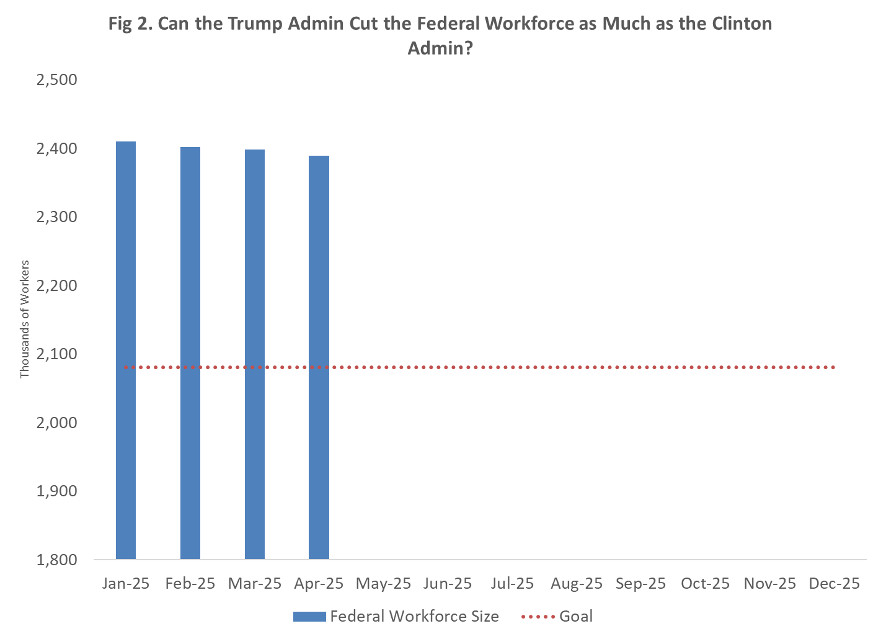Tracking Efforts to Shrink the Size of the Federal Workforce: April 2025 Update
April was another busy month for federal agency layoffs, and we even saw a resurrection of the Deferred Resignation Program. This is the third Bureau of Labor Statistics (BLS) report to capture at least some of these changes since the new administration issued Executive Order (EO) 14210 on “Reforming the Federal Workforce to Better Serve Americans.”
Before digging into the numbers, it is important to recognize that the BLS Current Employment Statistics report does not cover data all the way up to the end of the month. Instead, it is based on data collected during the reference week, which is typically the week that includes the 12th day of the month. For example, the latest report (April) primarily reflects employment data from the week of April 6-12, 2025. Any job changes occurring after that week—such as layoffs—will not be captured in that report but may appear in subsequent revisions or the next month’s report.
As of April 2025, there were 2.989 million federal government workers, excluding active military personnel. However, 600,000 of those workers were Postal Service employees. Excluding Postal Service workers, there were 2.389 million federal government workers. This is a decline of just 8,500 from last month, and a total decline in the federal workforce of 20,800 this year.
At the start of the month, agency heads from at least six federal agencies emailed offer letters to staff extending the offer to pay them through September if they quit by deadlines ranging from April 7 to April 18. The offer is a resurrection of the Deferred Resignation Program previously accepted by some 75,000 federal employees. Offer letters were emailed to staff at the General Services Administration and Departments of Energy, Agriculture, Housing and Urban Development, Defense and Transportation.
In my previous update, I mentioned that the Department of Health and Human Services (HHS) was planning to terminate about 10,000 positions. Starting the week of April 1, 10,000 workers were let go by agencies that operate under HHS, including the FDA, CDC, and NIH. The same week, 145 staff at the National Endowment for the Humanities (NEH) were placed on administrative leave effective immediately.
On April 4 the Internal Revenue Service (IRS) informed employees that it was planning to begin a phase of layoffs, which may include the possibility of early retirement and buyouts. Three sources indicated that, as of April 15, roughly 22,000 IRS workers wanted to take the offer of deferred resignation, or about a quarter of the IRS workforce. This is considerably more than the 4,700 workers who accepted the offer in the first round of resignations.
On April 8, the Supreme Court paused a prior ruling by Judge Alsup to reinstate more than 16,000 probationary employees that had been let go by the Pentagon, the Treasury, and the Agriculture, Energy, Veterans Affairs and Interior Departments.
The President signed a memo on April 17 extending the hiring freeze of federal civilian employees for an additional three months, through July 15. This is an extension of the January 20 order, which stated that no vacant positions can be filled and no new positions can be created. Once this extension expires in July, federal agencies will only be able to hire one new employee for every four employees who depart from federal service.
On the same day that the executive memo was signed, roughly 750 workers at AmeriCorps were placed on administrative leave until April 30, at which point their service was terminated. Roughly 90% of agency staff at the Consumer Financial Protection Bureau—up to 1,500 workers—were laid off the same day.
On April 22, Secretary of State Marco Rubio, announced that around 700 State Department employees will be cut in Washington, DC. The following day, OPM proposed a rule that would convert approximately 50,000 federal employees to an “at-will” employment status, making it easier for agencies to fire these workers. The proposed rule does not officially convert any federal positions, but the administration has signaled that an executive order will follow after the finalization of the rule.
Although it’s not taking effect until July 31, the Environmental Protection Agency (EPA) announced that 280 employees who work within agency DEI programs will be terminated.
With federal worker reductions scaling up, some media outlets have begun estimating the total number of terminations. For example, CNN, excluding those on administrative leave or who took voluntary buyouts, estimates that at least 121,000 federal jobs were terminated, but says that number could be as high as 280,000.
If we count the 22,000 IRS workers who plan to accept the offer of deferred resignation, then I would estimate that roughly 98,000 federal workers have accepted buyouts. Combined with an estimated 37,700 workers on administrative leave, and 20,800 workers no longer on federal payrolls, I would estimate that the upper limit of federal workers terminated, resigned, or placed on leave stands at roughly 156,500. In other words, about 87% of those impacted by workforce reduction efforts are still on federal payrolls as of April.
Can DOGE Efforts Match the Clinton Administration’s Achievements in Shrinking the Federal Workforce?
If the Trump administration is serious about meaningfully reducing the size of the federal workforce, then it should aim to reduce the number of federal employees at least by the same amount that the Clinton administration did in the four years between 1993 and 1997. This would require shrinking the federal workforce to fewer than 2.08 million workers by 2028, as I show in the tracker chart below.
To monitor the progress of DOGE’s federal workforce reduction efforts, I will update this tracker series monthly. This series of posts will cover workforce reductions, agency restructuring efforts, and any new policies or developments related to these initiatives. Stay tuned for regular updates on the Trump administration’s progress toward achieving its workforce reduction goals.




